人教版必修三unit5Canadathetruenorth公开课
- 格式:pptx
- 大小:10.35 MB
- 文档页数:34
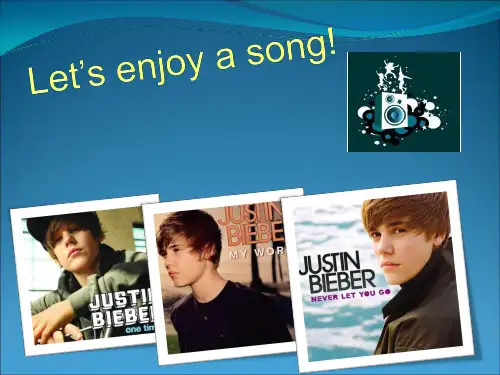
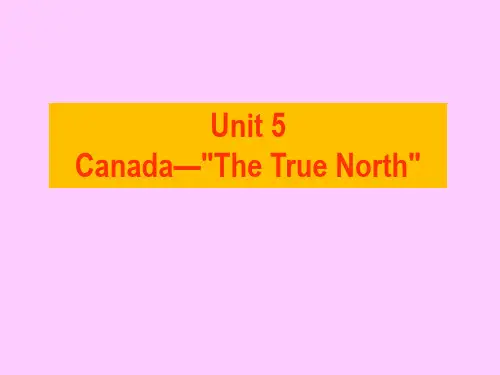
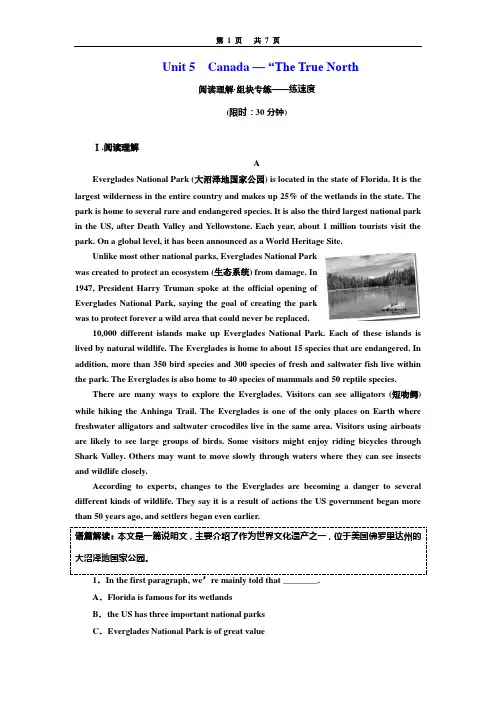
Unit 5Canada —“The True North阅读理解·组块专练——练速度(限时:30分钟)Ⅰ.阅读理解AEverglades National Park (大沼泽地国家公园) is located in the state of Florida. It is the largest wilderness in the entire country and makes up 25% of the wetlands in the state. The park is home to several rare and endangered species. It is also the third largest national park in the US, after Death Valley and Yellowstone. Each year, about 1 million tourists visit the park. On a global level, it has been announced as a World Heritage Site.Unlike most other national parks, Everglades National Parkwas created to protect an ecosystem (生态系统) from damage. In1947, President Harry Truman spoke at the official opening ofEverglades National Park, saying the goal of creating the parkwas to protect forever a wild area that could never be replaced.10,000 different islands make up Everglades National Park. Each of these islands is lived by natural wildlife. The Everglades is home to about 15 species that are endangered. In addition, more than 350 bird species and 300 species of fresh and saltwater fish live within the park. The Everglades is also home to 40 species of mammals and 50 reptile species.There are many ways to explore the Everglades. Visitors can see alligators (短吻鳄) while hiking the Anhinga Trail. The Everglades is one of the only places on Earth where freshwater alligators and saltwater crocodiles live in the same area. Visitors using airboats are likely to see large groups of birds. Some visitors might enjoy riding bicycles through Shark Valley. Others may want to move slowly through waters where they can see insects and wildlife closely.According to experts, changes to the Everglades are becoming a danger to several different kinds of wildlife. They say it is a result of actions the US government began more than 50 years ago, and settlers began even earlier.语篇解读:本文是一篇说明文,主要介绍了作为世界文化遗产之一,位于美国佛罗里达州的大沼泽地国家公园。
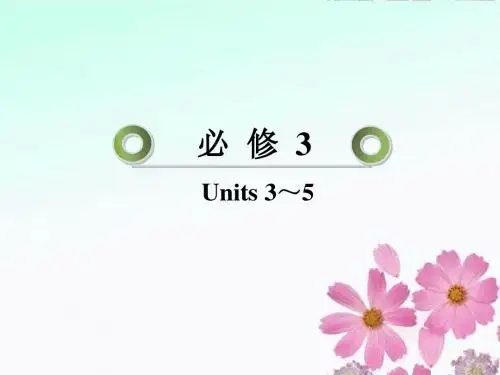
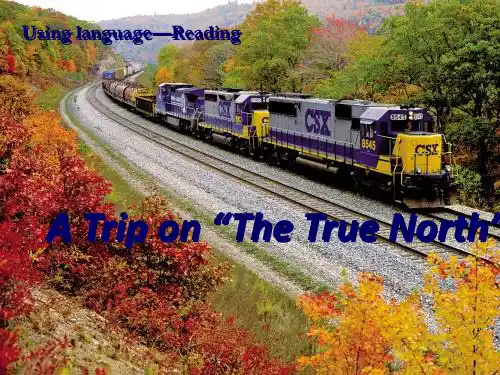
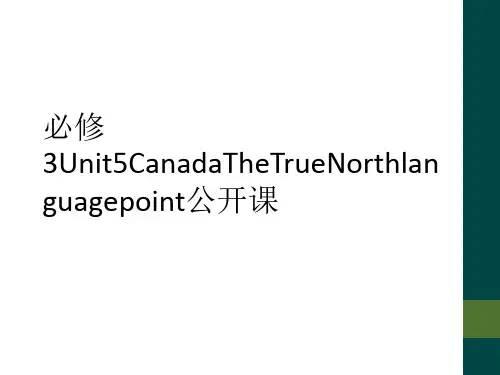

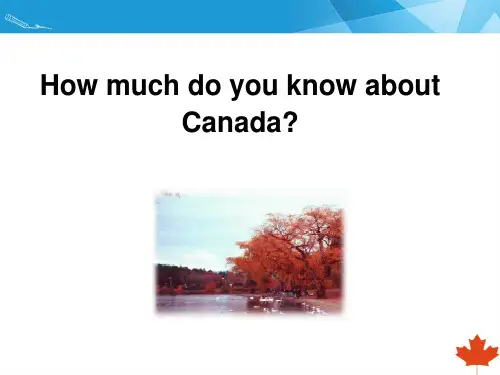
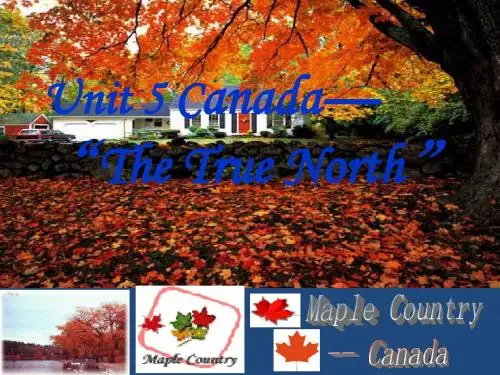
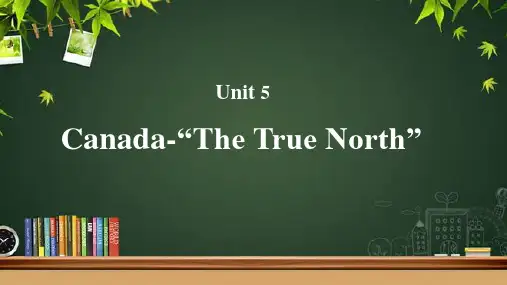
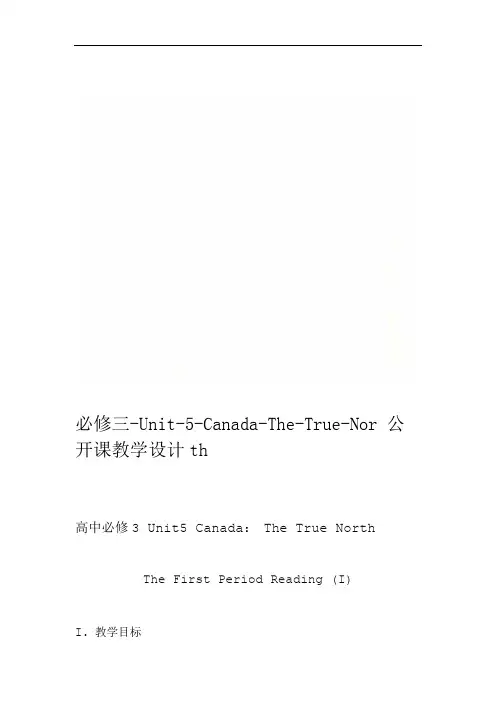
必修三-Unit-5-Canada-The-True-Nor 公开课教学设计th高中必修3 Unit5 Canada: The True NorthThe First Period Reading (I)I. 教学目标1. Language goalsa. Learn the use of the following words and phrases: Minister rather than,continent,surround, harbor, measure,aboard, have a gift for,within, manage to do, catch sight of, eagle, acre, urban settle down eastwardb. Important sentences:Learn about some sentence patterns and be able to use them freely.2. Ability goals1.) Learn how to describe the places that Li Daiyu and Liu Qian visit in Canada.Understand the noun clause used as appositive.2.) Enable the students to understand the details of the passage about Canada and find thecorrect answers to the questions in the post-reading.3. Learning ability goalsImprove the students' reading ability - searching for information.II. 教学重点Learn the information about Canada.Master the expressions for describing directions and locations.III. 教学难点Learn the methods of writing a traveling report about. Learn to read the traveling report according to the traveling route.IV. 教学策略选择与设计1. Skimming and scanning;2. Asking-and-answering activities;3. Listening method.学情分析V.本课为高一第二学期的一单元内容。
Teaching designReading: A Trip on “ the True North”Analysis of Teaching MaterialsThe material is from New Senior English For China Students’ Book 3, Unit 5 Canada---“The True North”. A Trip on the True North is a travel journal, introducing the travel experience of Li Daiyu and her cousin Liu Qian. Through this passage, students can have preliminary understanding of some basic information about Canada, including geographical environment, ecological environment, characteristics of major cities and related cultural activities. The reading plays a great role to illustrate this wonderful country and it offers good material to practice students’ reading skills.Analysis of studentsThe students of this class are Class 4, Senior 2. They have commanded a certain number of English words. Students love traveling. For them, traveling abroad can be an exciting thing and Canada can be an attractive country. However, not all of them have the experience of traveling by train.Teaching ObjectivesKnowledge aims:1. Master the key words, expressions and sentence structures.2. Understand the main idea of the passage.Ability aims:1. Develop the students’ reading skills, such as skimming, scanning, and careful reading.2. Cultivate students’ cooperative learning ability.Emotional aims:Get students to learn more about Canada,broaden students’ international view and develop their interests in western culture.Teaching Key Points and Difficulties1. To understand the passage and find out the travel route.2. Find the cities they crossed.Teaching Methods1.Task-Based Teaching Method2.Situational Teaching Method3.Cooperation Study MethodTeaching aidsA Multimedia computerTeaching ProcedureStep 1 Lead in (1’)My friend Lucy asked me to give her some suggestions on traveling in Canada. Can you help me? How much do you know about Canada?( The purpose of design: arouse students’ knowledge of Canada.)Step2 Warming up (7’)Watch a short video and after that answer questions.1. Canada is in ___________A. North AmericaB. South AmericaC. AustraliaD. Asia2. Canada is the ______ largest country in the world.A. 2ndB. 3rdC. 4thD. 5th3.Which is the national flag of Canada?A. B.C. D.4. What language (s) do Canadians speak?A. EnglishB. English and GermanC. English and FrenchD. English and Spanish5. What is the capital of Canada?A. VancouverB. TorontoC. CalgaryD. Ottawa6.Which is the national flower of Canada?A. cherryB. roseC. mapleD. lily7. What is the national animal of Canada?A. BeaverB. Grizzly bearC.polar bearD. penguin( The purpose of design: Students can know more information about Canada through the video.)Step3 Pre-reading (1’)Q1. What is the style of the passage?A. NarrativeB. ArgumentationC. ExpositionQ2. What the basic elements of the narrative?Who, What, When, Where, Why, How( The purpose of design: to know the elements of a narrative, and then understand the passage form these six elements.)Step4 While readingTask1 Skimming(3’)Read para.1 quickly and quietly and finish the following questions.Q1. Fill the tableQ2. Why did they decide to take the train instead of the airplane?Q3. What scenery can they see while going eastward?( The purpose of design: to find out the elements “When, Why, Where, How, What”.)Task2 Scanning (5’)Find the main stops and draw the travel route.China Montreal( The purpose of design: Find out the cities they crossed and then theycan have can get a clear travel route.)Task3 Careful reading (12’)● Vancouver1. What are the features (“most”s )?2. Fill in the chart.3. What could they see when they crossed the Rocky Mountains?● CalgaryQ1. What is Calgary famous for?Q2. What happens at the Calgary Stampede?Thunder Bay1. What kind of city is Thunder Bay?Thunder Bay is a busy ______city.2. Where is the Thunder bay?3. Canada has ________ of the world’s total fresh water.( The purpose of design: to understand the feature and more detailed information of the big cities: Vancouver, Calgary, Thunder Bay)Task3 Reflection (1’)What's your impression on Canada?( The purpose of design: to ask students to brainstorm their impression on Canada. )Step5 Post readingGroup work: If you were me, what places in Canada do you want to recommend(推荐)? Why?Useful sentences:1. The place I want to recommend is ________. /My favorite place is______. /I think/ believe _____is a good choice.2. Because it is_____. /The reason why you can go there is that______( The purpose of design: Through dialogue activities, students' English communication skills are exercised, their understanding of Canada is deepened, and their international vision is expanded)Step6 HomeworkTo search for more information about Canada on the Internet and replace me to write a letter to Lucy ( at least 100 words)●The places/ route you recommend.(推荐地方/ 路线)●Reasons ( 原因)●Blessing/ wish(祝愿)( The purpose of design: to write a letter according to what they learned, respond to the task that the teacher gives at the beginning of the class.) Analysis of the blackboard design.The blackboard will be divided into two parts. The left part is used to write words, expression and the information of the passage; the right, forflexible writing.。